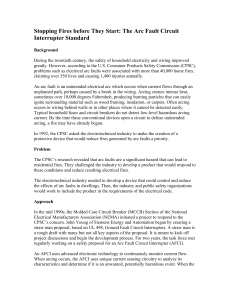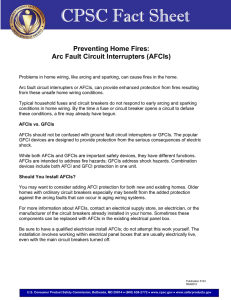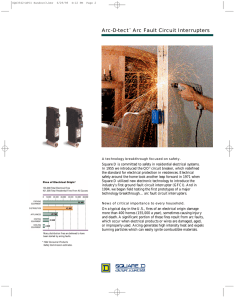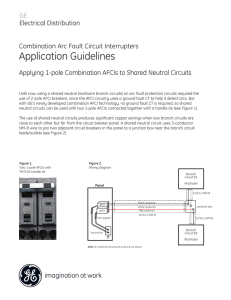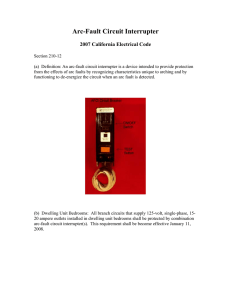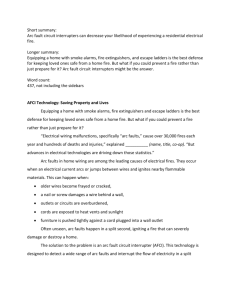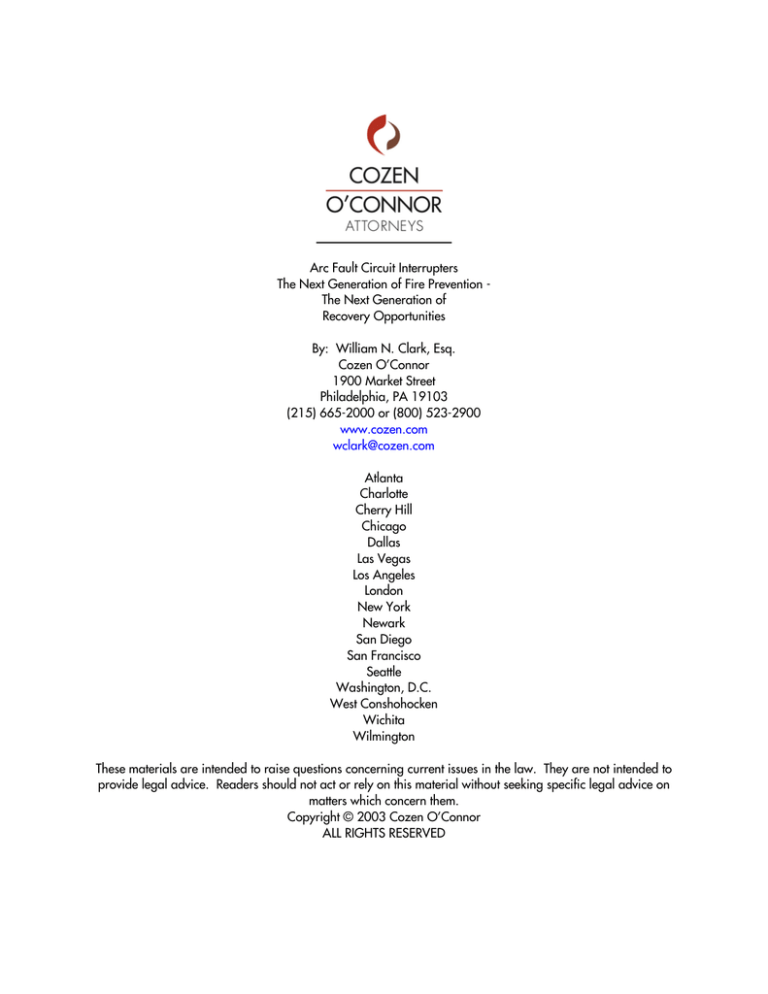
Arc Fault Circuit Interrupters
The Next Generation of Fire Prevention The Next Generation of
Recovery Opportunities
By: William N. Clark, Esq.
Cozen O’Connor
1900 Market Street
Philadelphia, PA 19103
(215) 665-2000 or (800) 523-2900
www.cozen.com
wclark@cozen.com
Atlanta
Charlotte
Cherry Hill
Chicago
Dallas
Las Vegas
Los Angeles
London
New York
Newark
San Diego
San Francisco
Seattle
Washington, D.C.
West Conshohocken
Wichita
Wilmington
These materials are intended to raise questions concerning current issues in the law. They are not intended to
provide legal advice. Readers should not act or rely on this material without seeking specific legal advice on
matters which concern them.
Copyright © 2003 Cozen O’Connor
ALL RIGHTS RESERVED
Manufacturers of electrical equipment have developed a new product that they claim is
at the forefront of circuit protection technology. This new product is called the Arc Fault Circuit
Interrupter (AFCI). AFCIs provide protection against arcing in fixed wiring, appliance cords and
extension cords. The United States Consumer Product Safety Commission (“CPSC”) and
National Association of State Fire Marshals ("NASFM") have called AFCIs the "most promising
fire protection technology since the advent of the smoke detector."i
This paper explores arcing, AFCI technology and recovery opportunities that may arise
from this new technology.
1.
The Fire Problem
During the five-year period between 1994 and 1998, there was an average of 73,500
electrical fires per year.ii Annually, electrical fires cause an average of 591 deaths, 2,247
injuries and $1,047,900,000 in property damage.iii Of the 73,500 electrical fires per year, 60,900
(82%) were caused by arcs.iv The CPSC estimates that AFCI technology can prevent 50-75%
of residential electrical fires.v Similarly, NASFM predicts that AFCI technology could prevent
55,125 fires annually, thereby saving 440 lives, 1,685 injuries and $785,925,000 in property
damage, if AFCIs are installed to protect all branch wiring in residences.vi
Residences are divided into four electrical zones. The electrical zones are designated
Zone 0 – from the utility service to the distribution panel; Zone 1 – from the panel to the branch
outlet; Zone 2 – from the outlet to the lighting or appliance fixture; and Zone 3 – the lighting
fixture or appliance. 2% of electrically caused fires occur in Zone 0, 36% in Zone 1, 12% in
Zone 2 and 50% in Zone 3.vii
2.
Arcing Fault Causes Of Fire
Arcs are caused by:
•
Pinched or pierced insulation on branch wiring, such as from staples or other
fasteners;
•
Cracked insulation on wire or cords from age, heat, chemical erosion or bending
stress;
•
Loose or improper connections;
•
Frayed or ruptured extension or appliance cords;
•
Damaged appliances;
•
Wire or cords touching vibrating metal;
•
Moisture or contaminates between conductors; and
•
Cord exposure to heating vents and sunlight.
3.
How The AFCI Works
Conventional circuit breakers respond to overloads and short circuits – they do not
protect against arcing conditions that produce erratic current. Like circuit breakers, AFCIs
protect against short circuits and overloads, but also protect against arcs by electronically
identifying the unique current and voltage characteristics of arc faults and de-energizing the
circuits when arc faults occur.viii
AFCIs use unique current sensing circuitry to discriminate between normal and
unwanted arcing conditions. Once an unwanted arcing condition is detected, the control
circuitry in the AFCI trips the internal contacts, de-energizes the circuit and reduces the potential
for a fire. AFCIs have been designed not to trip during normal arcing conditions that occur when
a switch is opened or a plug is pulled from a receptacle.
AFCIs are designed into conventional circuit breakers, combining traditional overload
and short circuit protection with arc fault protection. Currently, AFCIs are available for 15 and
20-ampere breakers for 125-volt circuits. There is no reason that AFCI technology will be limited
to these ratings and, as commercial demand for other ratings emerge, additional products will
be provided.ix
Since AFCIs are designed into conventional circuit breakers, AFCIs can be connected to
a standard electrical panel. AFCIs have test buttons on the circuit breaker similar to the test
buttons typically seen on ground fault interruption outlets. Currently, General Electric, CutlerHammer, Square D and Siemens offer AFCI circuit breakers.
4.
Types of AFCIs
There are six different categories of arc fault circuit interrupters. Each of these devices
is intended for different applications and/or protection of different aspects of branch circuit and
extension wiring. The types of AFCIs as defined by Underwriters Laboratories (“UL”) are:
•
Branch/Feeder AFCI – This device is installed at the origin of a branch circuit
or feeder, such as at a panelboard, to provide protection of the branch circuit
wiring, feeder wiring, or both, against unwanted effects of arcing. This device
also provides limited protection to branch circuit extension wiring (e.g. cord sets
and power supply cords). These may be circuit-breaker type devices or a
device in its own enclosure mounted at or near a panelboard.
•
Combination AFCI – This is an AFCI which complies with the requirements for
both branch/feeder and outlet circuit AFCIs. It is intended to protect
downstream branch circuit wiring, cord sets and power-supply cords.
•
Cord AFCI – This is a plug-in device for connection to a receptacle outlet to
provide arc protection to the power-supply cord connected to it.x
2
•
Leakage Current Detection And Interruption – This is a device provided in a
power supply cord or cord set that senses leakage current flowing between or
from the cord conductors and interrupts the circuit at a predetermined level of
leakage current.
•
Outlet Branch Circuit AFCI – This device is intended to be installed as the first
outlet in a branch circuit. It is intended to provide protection to downstream
branch circuit wiring, cord sets and power-supply cords against the unwanted
effects of arcing. These devices also provide protection to upstream branch
circuit wiring.
•
Outlet Circuit AFCI – This device is installed at a branch circuit outlet, such as
at an outlet box to provide protection of downstream cord sets and powersupply cords against the unwanted effects of arcing. This device may provide
feed-through protection of the cord sets and power-supply cords connected to
downstream receptacles.
•
Portable AFCI – This is a plug-in device for connection to a receptacle outlet. It
is intended to provide protection to connected cord sets and power-supply cords
against the unwanted effects of arcing.
While this paper concentrates on the Branch/Feeder AFCI, manufacturers of appliances
and appliance cords are starting to incorporate AFCI technology into their products. For
example, Black & Decker and Fire Shield have developed a line of toasters and a line of heaters
that use AFCI technology in the cord sets to protect against appliance cord fires. Fire Shield
claims to manufacture the cords with the intelligence to sense damage to cords and disconnect
power before a fire and currently offers extension cords and appliance cords that “sense pre-arc
conditions to prevent cord fires and shock hazards.”xi
5.
A Basic Understanding of Arcing
Circuit breakers are designed to detect overcurrent conditioning and short circuits. In
order to understand the differences between arc fault protection and traditional overcurrent
protection, a basic knowledge of the terms used with distributing electricity and overcurrent
protection is necessary.
•
Amp - An amp is the unit of measurement of electric current.
•
Ampacity - The current that a conductor can continuously carry under the
conditions of use without exceeding its temperature.
•
Arc - A luminous discharge of electricity across an insulating medium that exists
at temperatures between 5000°F and 15,000°F at its center.
•
Overcurrent - Any current in excess of the rated current of equipment or the
ampacity of the conductor, resulting from an overload, short, or ground fault.
3
•
Overload - Operation of equipment in excess of normal, full-load rating or of a
conductor in excess of rated ampacity, which, when continuing for a sufficient
period of time, causes damage or dangerous overheating.
•
Short circuit - An abnormal connection of low resistance between circuit
conductors; this is an overcurrent situation, but it is not an overload.
To better understand the conditions under which an AFCI will operate, a basic
understanding of the different types of arcs is necessary:
TYPE OF ARCING
EXAMPLES
DESCRIPTION
•
Parallel Arcing
Fault
An arc fault between the line and Damaged insulation.
neutral conductors in parallel with
the loads in the circuit.
•
Series Arcing
Fault
An arc fault in series with the
load resulting from loose
connections, severed wires,
damaged switches and similar
situations.
A nail that severs a wire.
•
Arcing to Ground
An unintentional arcing fault
between a part operating
normally at some potential to
ground and ground.
Wall plug or switch not
installed properly.
The following table developed by UL identifies the different types of arc fault scenarios,
the type of arc fault circuit interrupter and whether the type of arc fault circuit interrupter is
designed to prevent an arc in a given arc fault scenario.
Arc Fault Scenario
Branch
Feeder
Combination
Outlet
Circuit
Outlet
Branch
Circuit
Cord,
Portable
or LCDI
Y
Y
N
Y
Y
Y
n/a
n/a
n/a
N
Y
Y
n/a
n/a
n/a
Y
Y
N
Y
Y
Y
n/a
n/a
n/a
Y
Y
Y
n/a
n/a
n/a
Y
N
Y
Y
Y
Y
Y
Y
Y
Y
Branch Circuit Wiring-First Leg
Parallel Arcing Detection
Series Arcing Detection (With Ground)
Series Arcing Detection Without Ground (#)
Branch Circuit Wiring–Beyond First Leg
Parallel Arcing Detection
Series Arcing Detection (With Ground)
Series Arcing Detection Without Ground (#)
Cord Sets (Extension Cords), Power Supply Cords
Parallel Arcing Detection
Series Arcing Detection
4
Y – Arc fault protection provided
N – Arc fault protection not provided
n/a – Not applicable
(#) – Branch circuit wiring systems without ground were permitted prior to the 1962 NEC.
Parallel arcing detection includes arcing line-to-line and line-to-ground.
Cord and Portable AFCIs, and LCDIs are only intended to protect the cords connected to
them.
Combination AFCIs located at other than the origin of the branch circuit do not protect
upstream branch circuit wiring, cord sets, or power supply cords.
First Leg - Runs from the panelboard to the first outlet.
6.
The Legal Standards Applicable to AFCIs
UL 1699 “Standard for Arc Fault Interrupters” was first published in February of 1999.
UL 1699 provides the design and operational criteria for AFCIs. UL 1699.1 provides:
1.1 The requirements of this Standard cover arc-fault circuit-interrupters (AFCIs) of the
branch/feeder, outlet circuit, portable, and cord type intended for use in dwelling units.
These devices are intended to mitigate the effects of arcing faults that may pose a risk of
fire ignition under certain conditions if the arcing persists.
1.3 These devices are not intended to detect glowing connections.
1.5 An AFCI that is also intended to perform other functions, such as overcurrent
protection, ground-fault circuit-interruption, surge suppression, any other similar
functions, or any combination thereof, shall comply additionally with the requirements of
the applicable Standard or Standards that cover devices that provide those functions.
AFCIs must pass three tests to meet UL 1699:
56.2 Carbonized Path Arc Ignition Test – AFCI shall interrupt the electric circuit to the
load before ignition of a cotton fire indicator.
56.3 Carbonized Path Arc Interruption Test – AFCI shall clear the arcing fault if 8 halfcycles of arcing occur within a period 0.5 seconds.
56.5 Point Contact Arc Test – AFCI shall clear the arcing fault if 8 half cycles of arcing
occur within a period of 0.5 seconds.
While UL 1699 provides the design and operational criteria for AFCIs, the National
Electric Code (NEC) provides the guidelines for the minimum required use of AFCIs. In 1999,
NEC 210-12 was amended to require AFCIs to protect all branch circuits providing power to
outlets in dwelling unit bedrooms (new construction) effective January 1, 2002.
The NEC is a model code for electrical wiring. Individual states and authorities having
jurisdiction have adopted their own initiatives and schedules for the required installation of
AFCIs. For example, Vermont has adopted an electric code that requires AFCIs to protect all
branch circuits for all living spaces for all new construction starting January 1, 2001. Thus,
Vermont’s code requires greater AFCI protection (all circuits in living areas as opposed to just
bedrooms) a full year earlier than the NEC’s required protection for bedrooms.
5
The NEC had enacted a provision requiring AFCI cord protection for all room air
conditioners manufactured for use in the United States starting December 19, 2003. Due to the
difficulty in implementing the program, UL and the NEC moved the compliance date to August of
2004.
The next edition of the NEC will be published in 2005. Several proposals have been
submitted seeking to amend the NEC to require AFCIs for mobile homes and for all living
spaces in new construction. In addition, the CPSC has submitted a proposal that would require
AFCIs to be installed in existing homes when the electrical service for existing homes is
replaced or up-dated.
It is unclear what additional AFCI requirements will be adopted between
now and the 2005 edition of the NEC. However, several jurisdictions have already taken steps
to increase the requirements for AFCI protection beyond the requirements contained in the
NEC. For example, the 2002 Massachusetts Electrical Code requires AFCI protection for
dwelling unit bedrooms for existing structures where panel boards are replaced (effective
January 1, 2005).xii Similarly, the City of St. Paul, Minnesota, interprets the NEC to require
AFCI protection for bedroom additions to existing structures and when new outlets are installed
in existing bedrooms.xiii
7.
Potential Recovery Theories
At first, the development of AFCI technology appears to limit recovery opportunities by
preventing fires. However, the development of arc fault circuit interrupters may actually
increase recovery opportunities, despite the potential for reducing the number of fires. Many
residential electrical fires have unspecified origins due to the extensive electrical damage to the
house wiring, appliance cords and appliances in the area of origin. As subrogation
professionals, we have all closed cases after the cause and origin and/or electrical engineer
determined the fire to be "unspecified electric". Furthermore, we have all closed files due to
faults in older branch wiring where the cause and origin and/or electric engineer could not
determine the reason for the fault in the branch wiring. Cases against the entities involved in
manufacturing, selling, installing and servicing AFCIs may have provide recovery opportunities
in many of these cases that would have been closed before the development of AFCIs.
A.
Recovery Against Manufacturers of Branch Circuit AFCIs
The most obvious, but potentially most difficult, avenue of recovery is against the
manufacturers of AFCIs. Recovery against manufacturers will be difficult due to the recognition
by UL, AFCI manufacturers and other professionals that AFCIs mitigate against arcs and cannot
completely eliminate arcs under every circumstance. Despite the potential difficulty in pursuing
a case against the manufacturer of an AFCI, a thorough investigation by an electrical engineer
may assist in developing a viable recovery theory.
The first step in determining whether there is a potential recovery against the
manufacturer of an AFCI is to determine if the wiring that exhibits arcing was protected by an
AFCI. With all new technology, there will be a lag before persons in the field become fully
educated concerning this new technology. Thus, cause and origin investigators and electrical
engineers hired to investigate electrically caused fires should be educated or reminded to look
for AFCIs to determine whether the arcing occurred on a circuit that was AFCI protected.
6
By using UL’s arc failure scenario chart, you and your experts can determine if
the specific type of AFCI was designed to protect against the arc failure scenario at the fire
scene. Once you have determined that the AFCI was designed to protect against the particular
arc failure scenario, several theories of recovery may arise.
i)
Manufacturing Defect
The AFCI can be non-destructively and destructively examined to
determine if there was a failure in the AFCI. By using X-rays and disassembling the breaker, it
can be determined whether the breaker failed to operate as it was designed to operate.
Special care should be taken when conducting a forensic examination of
an AFCI. AFCI circuitry can be damaged by electrical surges. This damage can cause the AFCI
not to trip in response to an arc fault. Thus, in order to establish a manufacturing defect case,
your forensic investigation will most likely have to eliminate damage to the AFCI computer chip
as a possible cause of the failure of the AFCI to respond to an arc fault
ii)
Failure to Warn
The warning and instructions provided by the manufactures of AFCIs may
create potential recovery opportunities. The packaging, installation instructions and warnings
do not mention that surges can damage AFCI circuitry. Rather, manufacturers rely on an insert
card to instruct the user to conduct a monthly test of the AFCI to determine if it is operational.
The warnings and instructions do not warn the consumer or instruct the licensed electrician to
instruct the consumer to conduct the monthly test of the AFCI. Therefore, one of the first
battlegrounds between victims of fires and AFCI manufacturers will be over the sufficiency of
the manufacturers’ warnings and instructions. Thus, the warnings and instructions provided by
the manufacturer of the AFCI should be consulted where an AFCI has failed to detect an arc
fault and the insured had not been conducting the monthly testing of the AFCI.
iii)
Malfunction Theory
Most states permit plaintiffs to prove a products liability claim through a
legal doctrine know as the malfunction theory. The malfunction theory permits a plaintiff to prove
a product defect by eliminating the reasonable sources for an accident or for a fire. Proving a
malfunction case against an AFCI manufacturer will be extremely difficult, if not impossible,
because of the difficulty in eliminating other potential sources for the failure of an AFCI to
respond to an arc fault. Without a specific product defect, AFCI manufacturers will be able to
argue that the arc started the fire before the AFCI could sense the arc and/or that the circuitry
was damaged by an electrical surge.
B.
Contractors
i)
Failing To Follow The Code
One theory of recovery is against builders and contractors who do not
incorporate AFCIs in panel boxes for new construction after January 1, 2002 in violation of the
NEC. Local codes and standards should be consulted to determine if AFCIs were required to
protect the circuit that caused a particular fire. Depending on the individual jurisdictional
requirements, you may find that the builder or contractor violated the code by failing to install
AFCIs.
7
One unresolved issue under the code is whether the National Electric
Code requires AFCIs in newly constructed hotels, motels and similar structures where there are
bedrooms/sleeping areas. In such cases, a strong argument exists that the overall intention of
the life safety aim of the code is not satisfied unless the design professional or contractor
installed (or at least recommended the installation) of AFCIs for newly constructed hotels,
motels and similar structures.
ii)
Failing To Properly Install And Test The AFCI
Another possible theory against contractors is the failure to properly
install the AFCI and to test it after its installation. The AFCI must be installed in accordance with
the manufacturer’s instructions and tested in compliance with those instructions. Companies
have already started developing UL certified testers that test each circuit protected by the AFCI
to make sure that the AFCI is operating properly. It should be determined whether the AFCI
was installed in compliance with the manufacturer’s recommendations and tested to make sure
that it was operating properly at the time of its installation.
iii)
Failing To Install Or Recommend The Installation Of AFCIs
In addition to cases arising out of the failure to install code-required
AFCIs, theories may be formulated resulting out of a contractor’s failure to warn and
recommend that additional AFCIs be placed into living spaces. For example, in new
construction, the issue is whether the design professional, general contractor or electrical
subcontractor should have recommended to the purchaser of the residence that AFCIs be
installed to protect branch circuits in all living areas.
Another potential theory arises out of renovations to homes and/or
updating of electrical service. The 2002 edition of the NEC does not require that AFCIs be
installed in panel boxes when a new panel box is installed in existing construction.
Nevertheless, an argument can be made that when an electrician replaces a panel in an
existing residence that the electrician should install AFCIs because the risk of arcing is greater
in older construction than in new construction as evident from of the greater frequency of fixed
wiring fires in construction that is over ten years of age. The Massachusetts Electrical Code
provides a perfect example of a situation where an electrician’s compliance with the code may
not discharge the electrician’s duty of due care. The 2002 Massachusetts Electrical Code
requires AFCI protection for existing homes that undergo panel board replacement starting
January 1, 2005. This code requirement can be used to establish that electricians in
Massachusetts have knowledge of the safety benefits of AFCIs in existing construction and
should be installing AFCIs in new panel boards for existing dwellings, starting in 2002.
If a potential case exists against a design professional, general contractor
or electrical subcontractor for failing to install AFCIs, there is a significant body of information
available to the subrogation practitioner to use in establishing that the code is the minimum
standard of care and that a reasonably prudent design professional or contractor should have
installed AFCIs. For example, the CPSC recommends AFCI protection for both new and
existing homes and recommends that older homes especially may benefit from the added
protection against arcing faults that can occur in aging wiring systems.xiv Furthermore, electrical
equipment manufacturers are starting to develop and market AFCI protection for commercial
uses. For example, General Electric is now marketing AFCIs for office buildings and hotels.
8
C.
Appliance/Cord Manufacturers
Fire Shield has developed AFCI/LCDI technology for cord sets and extension
cords. Black & Decker has incorporated this technology in its new heaters and toasters. Fire
Shield and Black & Decker may have set the design benchmark for all manufacturers of cords
and appliances. When faced with a fire caused by a power-strip, extension cord or appliance
cord, the insured should be interviewed as to the date of the purchase and possible theories
that exist against the appliance/cord manufacturer for failing to include the AFCI technology in
recently manufactured products. In cases involving cords that have the AFCI technology, and
arcing there may be failure to warn or manufacturing defect theories.
8.
Conclusion
The widespread use of AFCIs may or may not result in a decrease in subrogation cases
due to the expected decrease in fires caused by arcing. It is too early to tell whether arc fault
technology will prevent fires. Furthermore, it is too early to determine whether recovery
possibilities exist in situations where arc fault technology has been employed, but failed to
detect an arc. However, as subrogation professionals, we should be aware of this new
technology so that we can better serve our clients by investigating potential cases against AFCI
manufacturers and the construction professionals charged with the duty of designing and
installing electrical distribution systems.
PHILA1\1763808\1 099994.000
i
George E. Miller, President NASFM, May 30, 2002 report to Donald A. Bliss, Consumer
Product Fire Safety Task Force.
ii
George E. Miller, President NASFM, May 30, 2002 report to Donald A. Bliss, Consumer
Product Fire Safety Task Force.
iii
George E. Miller, President NASFM, May 30, 2002 report to Donald A. Bliss, Consumer
Product Fire Safety Task Force.
iv
George E. Miller, President NASFM, May 30, 2002 report to Donald A. Bliss, Consumer
Product Fire Safety Task Force.
v
King William H. Jr., Chief Engineer for Electrical Fire & Safety, Division of Electrical
Engineering, U.S. Consumer Product Safety Commission, in discussion with the N.A.S.F.M.
Science Advisory Committee, July 14, 2002.
vi
George E. Miller, President NASFM, May 30, 2002 report to Donald A. Bliss, Consumer
Product Fire Safety Task Force.
vii
Illinois Electric Counsel Fact Sheet, Number 28. www.iecounsel.org/educational/fs28.html.
viii
Divid Dini, UL Senior Research Engineer, Arc Fault Circuit Interrupters, IAEINEWS,
September 2001.
9
ix
George Gregory, Square D Company, A Brief On The Arc-Fault Circuit Interrupter.
www.hq.usae.army.mil/cemp/e/et/arcpoult.pdf
x
Arc Fault Testing and Arc Fault Scenarios, January 28, 2002- Underwriters Laboratories.
xi
Fire Shield Product Literature www.fireshield.com.
xii
527 CMR 12.210.12(C).
xiii
City of St. Paul, Office of License, Inspections and Environmental Protection, Bulletin 01-1,
and Bulletin 02-1. www.ci.stpaul.mn.us/depts/liep/pdf/building/electric/bulletin01-1.pdf
xiv
Consumer Product Safety Commission Pamphlet – Preventing Home Fires: Arc Fault Circuit
Interrupters (AFCIs). www.cpsc.gov/cpscpup/pubs/afci.html.
10

